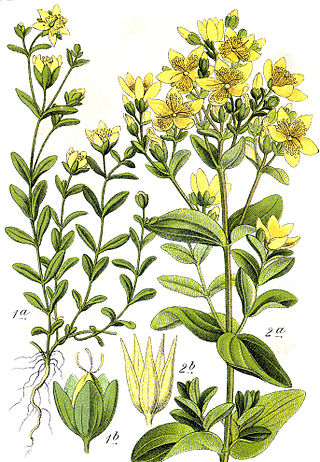
Hypericum tetrapterum is a herbaceous perennial plant species in the flowering plant family Hypericaceae. Its common names include St. Peter's wort, Peterwort, square stemmed St. John's wort, and square stalked St. John's wort.
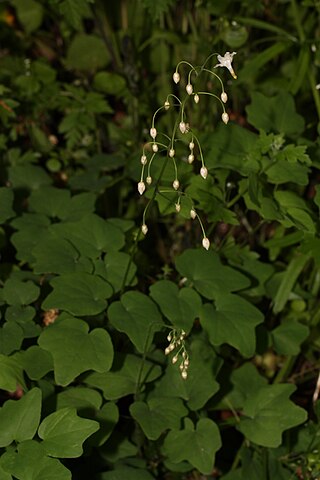
Vancouveria is a small group of plants belonging to the barberry family described as a genus in 1834. The three plants in this genus are known generally as inside-out flowers, and they are endemic to the West Coast of the United States. The genus was named after George Vancouver, English navigator and explorer.
- Vancouveria chrysanthaGreene – golden inside-out flower – California, Oregon
- Vancouveria hexandra(Hook.) C.Morren & Decne. – white inside-out flower – northwestern California, western Oregon, southwestern Washington
- Vancouveria planipetalaCalloni – redwood inside-out flower – California as far south as Monterey County, southwestern Oregon

Thalictrum dioicum, the early meadow-rue or quicksilver-weed, is a species of herbaceous plants in the family Ranunculaceae. Plants are typically upright growing woodland natives from Colorado Rocky Mountain forests to central and eastern North America including parts of south eastern Canada. This species has dioecious plants, with male and female flowers on separate plants blooming in early to mid spring.
Verticordia brevifolia is a flowering plant in the myrtle family, Myrtaceae and is endemic to the south-west of Western Australia. It is a small shrub with shortly cylindrical leaves and bright yellow flowers which turn red as they age. There are two subspecies, both of which have limited distributions and a priority conservation rating.

Calochortus amabilis is a species of the genus Calochortus in the family Liliaceae. It is also known by the common names Diogenes' lantern, yellow globe-tulip, golden globe-tulip, yellow globe lily, golden fairy lantern, golden lily-bell, Chinese lantern, and short lily.

Calochortus persistens is a rare North American species of flowering plant in the lily family known by the common name Siskiyou mariposa lily. It is native to northern California and southern Oregon.
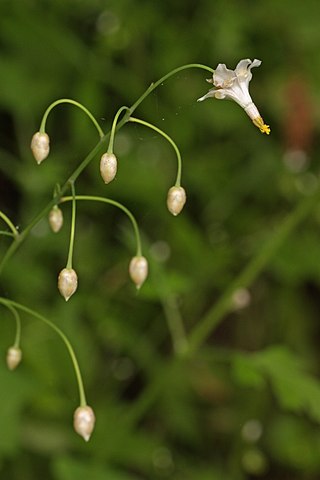
Vancouveria hexandra, the white inside-out flower, is a perennial herb in the barberry family Berberidaceae. It is found in southwestern British Columbia, western Washington and Oregon and northwestern California and is a common understory herb in moist, shady Douglas fir forests.

Verticordia galeata is a flowering plant in the myrtle family, Myrtaceae and is endemic to the south-west of Western Australia. It is a woody shrub with thin, pointed cylinder-shaped leaves and heads of bright yellow flowers on the ends of the branches in spring.

Minuartia stolonifera is a rare species of flowering plant in the pink family known by the common names Scott Mountain sandwort and stolon sandwort.

Ribes speciosum is a species of flowering plant in the family Grossulariaceae, which includes the edible currants and gooseberries. It is a spiny deciduous shrub with spring-flowering, elongate red flowers that resemble fuchsias, though it is not closely related. Its common name is fuchsia-flowered gooseberry. It is native to central and southern California and Baja California, where it grows in the scrub and chaparral of the coastal mountain ranges.
Ribes marshallii is a North American species of currant known by the common names Hupa gooseberry and Marshall's gooseberry. It is endemic to the Klamath Mountains of southern Oregon and northern California.
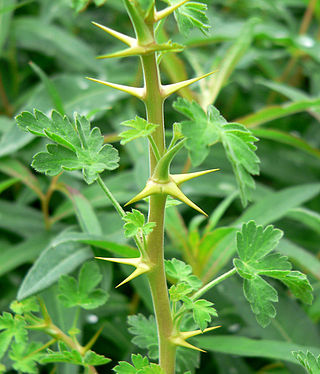
Ribes montigenum is a species of currant known by the common names mountain gooseberry, alpine prickly currant, western prickly gooseberry, and gooseberry currant. It is native to western North America from Washington south to California and east as far as the Rocky Mountains, where it grows in high mountain habitat types in subalpine and alpine climates, such as forests and talus. It is a spreading shrub growing up to 1.5 meters tall, the branching stems covered in prickles and hairs and bearing 1 to 5 sharp spines at intervals.

Ribes quercetorum is a species of currant known by the common names rock gooseberry, oak gooseberry and oakwoods gooseberry. It is native to the mountains and hills of California from the San Francisco Bay Area south into Baja California and east into Arizona.

Ribes velutinum is a species of currant known by the common name desert gooseberry.
Caladenia robinsonii, commonly known as the Frankston spider orchid is a plant in the orchid family Orchidaceae and is endemic to Victoria. It is a ground orchid with a single hairy leaf and one or two red and creamy-yellow flowers with dark red glandular tips on the sepals. In 2010 only about forty specimens of this plant, growing in a single population were known.
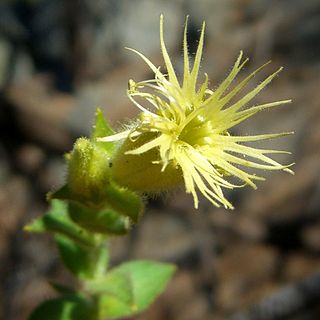
Silene parishii is a species of flowering plant in the family Caryophyllaceae known by the common name Parish's catchfly. It is endemic to southern California, where it is known from several of the local mountain ranges, including the San Bernardino, San Gabriel, and San Jacinto Mountains. It grows in rocky, forested habitat, sometimes in the alpine climates of the higher peaks. It is a perennial herb growing from a woody, branching caudex and taproot, sending up several decumbent or erect stems 10 to 40 centimetres tall. The oppositely arranged leaves line the stems, the largest ones located at the middle of each stem. Leaves are lance-shaped to nearly oval and up to 6 centimetres long. They are thick and leathery, and sometimes glandular and sticky. Each flower is encapsulated in a tubular calyx of fused sepals which may be nearly 3 centimetres long. It is greenish with ten veins and a coating of glandular hairs. The five petals are yellowish in colour and each has about six long, fringelike lobes at the tip.
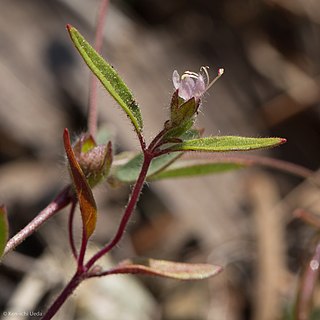
Trichostema simulatum is a species of flowering plant in the mint family known by the common name Siskiyou bluecurls.
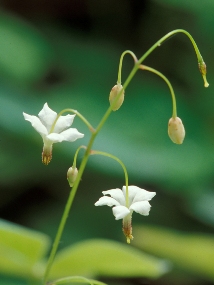
Vancouveria planipetala is a species of flowering plant in the barberry family known by the common names redwood inside-out flower and redwood ivy.

Verticordia chrysantha, commonly known as yellow featherflower or yellow Morrison, is a flowering plant in the myrtle family, Myrtaceae and is endemic to Western Australia. It is a small, slow-growing, rather bushy shrub with bright yellow flowers which often turn reddish-brown as they age. It is widespread in the south-west of the state.
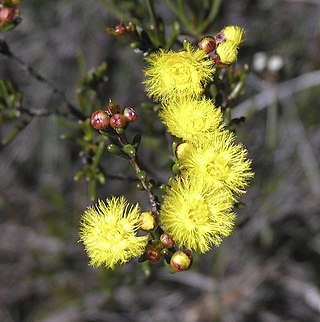
Verticordia chrysanthella, commonly known as little chrysantha, is a flowering plant in the myrtle family, Myrtaceae and is endemic to the south-west of Western Australia. It is a shrub with cylinder-shaped leaves and small groups of lemon-yellow to gold-coloured flowers which fade to orange, red or brown.

















